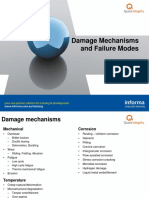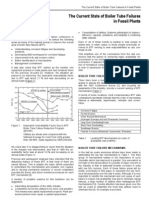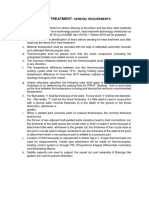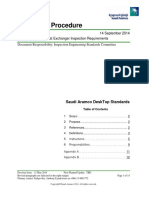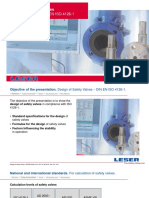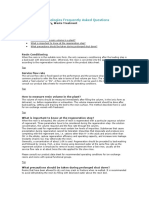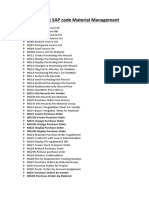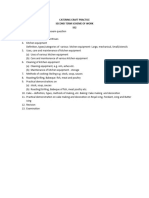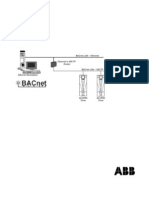Basic of Ion Exchange Part-2
Basic of Ion Exchange Part-2
Uploaded by
Zeeshan TalibCopyright:
Available Formats
Basic of Ion Exchange Part-2
Basic of Ion Exchange Part-2
Uploaded by
Zeeshan TalibCopyright
Available Formats
Share this document
Did you find this document useful?
Is this content inappropriate?
Copyright:
Available Formats
Basic of Ion Exchange Part-2
Basic of Ion Exchange Part-2
Uploaded by
Zeeshan TalibCopyright:
Available Formats
Basic Ion Exchange
for Residential
Water Treatment
Part 2
By Michael C. Keller
In our February issue, Keller explained the This is an oversimplified but accurate ex- tion in rinse is dependent on the system
histor y of ion exchange, the manufacturing planation. design (it must have good distribution).
and softening processes, disinfection and Countercurrent regeneration can be The reason for greater efficiency is due
standard removal methods. We now bring a technique used to improve efficiency; to the fact that the rinse water has hard-
you part two, which begins with a look at however, the main benefit to countercur- ness. Any reduction in rinse volume will
efficiency factors. rent regeneration is the reduction of leak- reduce the amount of exhaustion that
ages as compared to cocurrent regenera- occurs during the rinse cycle. When less
Efficiency rinse water is used, less ex-
In many parts of the country, Table 3. Comparative evaluation— haustion occurs during the
drought has caused the water treatment fine mesh vs. standard mesh regeneration, so there is
industry to look for more efficient meth- more capacity during the
Standard resin Fine mesh resin
ods to soften water. California is in that service cycle.
operating operating
process (in some counties) and has en- As stated pr eviously,
capacity capacity
acted laws (in other counties) requiring the greatest benefit to a
(kgr/cf) (kgr/cf)
softeners to have an efficiency rating of countercurrent system is
Regeneration level salt efficiency salt efficiency
3,250 grs./lb. of salt. These laws were lower leakage. In a cocurrent
(lbs./cf @ 10%) (kgr/lbs. of salt) (kgr/lbs. of salt)
implemented to reduce the amount of salt system the brine is intro-
being sent to the drain. This goal cannot 5 22.2 / 4.44 23.9 / 4.78 duced in the same direction
be attained when using high salt dosages. 10 29.0 / 2.90 31.5 / 3.15 as the service flow. When the
The lower the salt dosage, the greater the 15 31.3 / 2.09 34.0 / 2.27 bed is exhausted and salt is
efficiency of the unit (See Table 3—no- 20 33.6 / 1.68 36.6 / 1.83 passed through the system,
tice that standard resin when regenerated top to bottom, a heel of ex-
25 35.7 / 1.43 39.0 / 1.56
with 5 lbs. of salt/cu.ft. can achieve an hausted resin is left at the
efficiency of 4.44 kgr./lb. of salt, while Softening cycle – downflow 3 gpm/cf bottom of the unit. A coun-
10 lbs./cu.ft. will attain only 2.9 kgr./lb. Regeneration – upflow 0.5 gpm/cf tercurrent unit which runs
of salt). Resin bed depth – 24 inches opposite to a cocurrent sys-
Fine mesh resin will also increase Operating capacity end point – 10 ppm total hardness tem will leave a heel of ex-
efficiency. This is the result of better ki- hausted resin on top of the
netics. The resin has greater surface area, tion (See Table 4). With countercurrent unit. When the system goes back on line,
so the exchange of hardness onto the regeneration, the brine solutions r un op- the heel of hardness must pass through
resin is mor e efficient. Laboratory test- posite the service flow. Ca-
ing has shown that fine mesh resin gives pacity is not incr eased Table 4. Countercurrent water softening
approximately 10 percent more capacity during the actual brining of for high hardness and high solids
than standard softening resin. The ex- the resin; it occurs during the
haustion band formed during the service rinse cycle. In a cocurrent Conventional
cycle contains both exhausted and regen- system, the total rinse can be (Cocurrent) Countercurrent
erated resin. Standard resin may have a 5-10 bed volumes or 40-80 Influent —TDS 1,500 ppm 1,500 ppm
10-inch exhaustion band, while fine mesh gallons. The rinse in the —TH 700 ppm 700 ppm
resin has a 9-inch exhaustion band. For countercurrent system may Regenerant (NaCl) 10 lbs./cu.ft. 7.5 lbs./cu.ft.
this reason, the fine mesh resin system be as low as 2-5 bed volumes
Hardness leakage 25-30 ppm 1-2 ppm
will have one more inch of usable resin. or 15-40 gallons. The reduc-
MARCH 2005 Water Conditioning & Purification 17
the entire bed before exiting the unit. This give a life expectancy of 3-6 years. When water retention of 45-48 percent. If oxi-
procedure can reduce leakage by 90 per- chlorine levels are excessive, a higher dation is occurring the water retention
cent or more. Residential users will gen- crosslinked resin can be used. There are will increase. This increase is generally
erally not need to have the low leakages other factors that influence the life ex- due to chlorine. Chlorine will attack the
that countercurrent systems are capable pectancy of resin, like metal fouling. To crosslinking of the resin and cause it to
of producing. If there were one grain of check for metal fouling, take a small become mushy. This kind of degradation
leakage, most people would never notice. sample of resin (one ounce) and place it will cause pressure drop and channeling,
However, there ar e many applications in a glass jar. Add muriatic acid (HCl) to as well as a deterioration of the capacity.
in commercial and industrial markets a level about one inch above the resin. The bead count shows the amount
that require low hardness leakage. Let this set for about one hour. A yellow of whole and broken beads. The concen-
Countercurrent systems can be op- to orange color will develop. The darker tration of broken beads is most impor-
timized for better results. First, the sys- the color, the heavier the iron fouling. If tant. A high amount of broken beads will
tem can be packed, which can be accom- a blue color develops, it generally means lead to channeling and pressur e drop. A
plished by filling the tank with resin or a copper fouling has occurred. These are thorough, extended backwash can be
combination of polypropylene beads on simple tests that can give you a basic idea used to reduce the percentage of broken
top of the softening resin. This will pre- of the resin’s condition. beads.
vent the bed from turning over. The goal If problems occur and the system is The final test is for iron fouling. In
of this type of regeneration is to have the large enough, the resin can be tested by this test, the amount of iron on the resin
heel of exhausted resin on top of the bed. a laboratory. Standard testing includes is tested in grams of Fe/cu.ft. Hydrochlo-
If the bed fluidizes, the heel of exhausted total capacity, softening capacity, water ric acid is the best agent to use to remedy
resin will be distributed throughout the retention, bead count and iron fouling this condition. However, as stated previ-
whole system. Backwashing will not flu- (See Table 5). It is important to properly ously, care must be taken when using
idize and expand the bed to reduce sol- sample the resin bed: a grain thief can be HCl. It is corrosive to the metal parts in
ids that have been filtered out by the bed. used to obtain a representative sample of valves and if the resin is not regenerated
If iron is contained in the influent water, the whole resin bed. Resin can also be back to the Na form, a low pH will result
a reducing agent should be used to clean pulled from different levels of the bed, in the service cycle. Other reducing
it frequently. Salt containing a reducing so a representative sample is taken for agents, which are easier to handle, in-
agent would be very beneficial. analysis. If the sample is removed from clude sodium hydr osulfite, sodium
Even if the countercurrent system is only the top of the bed, the results will bisulfite, citric acid and phosphoric acid.
allowed to fluidize, it will give better re- more than likely show the resin to be in This iron test can also be used to deter-
sults than a cocurrent system. The heel poor condition. Resin from the top of the mine other types of metal fouling, like
of exhausted resin will be distributed bed will usually have a high degree of copper and aluminum. To treat copper
throughout the bed, but it will not be fines (small beads), broken beads and iron and aluminmum fouling, phosphoric acid
concentrated at the bottom of the bed fouling. A sample from the bottom of the or hydrochloric acid needs to be used,
like cocurrent regenerations. The brine bed will generally be in good condition. since other reducing agents may not be
in this system can be passed through the Either way, the analysis will not be rep- strong enough to reverse metal fouling.
bed at such a flow rate that the bed may resentative of the entire bed of resin. Note that the metal fouling test only re-
only expand 10-15 percent. By doing this, Total capacity is a measurement of ports reversible fouling.
the heel of exhausted resin will stay at the resin’s theoretical capacity. New resin Again, it is important to obtain a rep-
the top of the bed to a greater degree. has a total capacity of 1.9 to 2.0 meq/ml. resentative resin sample testing. Resin
The brine cycle can also be used as the Irreversible fouling or oxidation will from the top of the bed will have higher
backwash. Pulse brining will give the cause this parameter to decrease. The amounts of broken and fine beads along
same effect. softening capacity is more indicative of with higher amounts of iron fouling. A
how the unit is working in the field. New good representative sample can be ac-
Resin degradation and resin will have a softening capacity simi- quired by sticking a PVC pipe down
sampling lar to the total capacity. In the test proce- through the entir e bed. (See Chubb
Softening resin can last 15-20 years dure, the resin is regenerated with salt, Michaud’s article “Sampling Quality and
or more in unstressed conditions. Chlo- then exhausted with calcium chloride. the Quality of the Sample—The key to
rine and metal fouling are the primary The difference between the total and soft- good resin management is good sam-
culprits in resin degradation. There are ening capacity text procedure is that hy- pling,” WC&P November 2004.)
some quick and dirty tests that can give drochloric acid is used in the total capac- Resin should be stored in an area
information pertaining to resin quality. ity procedure. If there is a precipitated that will prevent it from freezing. Fr e-
First, take a sample of resin and place it iron fouling the softening resin, the total quent freezing and thawing causes resin
between your thumb and index finger capacity may be within specification. to break down physically. If resin freezes
and rub. If the resin breaks up, it has been However, the softening capacity on the once or twice, it should not be negatively
oxidized by chlorine. There is a general same softening resin will be poor. Salt affected. Resin is sold in the fully swol-
rule that can be used to predict the effect will not remove ir on fouling from the len moist form and should not be allowed
of chlorine on resin life. This rule states resin. If ther e is a difference between the to dry out. Upon wetting, the resin may
that for each ppm of chlorine in the in- softening capacity and the total capacity, fracture, causing br oken beads to form.
fluent water, the resin life will be cut in it is generally due to reversible metal In many cases, ion exchange resins that
half. This guideline should only be used fouling. have lost significant amounts of mois-
as an estimate. For example, if there is Capacity lost to oxidation is unre- ture, appearing dehydrated, do still have
one ppm of chlorine in the influent wa- coverable. The water retention is the sufficient water in the interstitial spaces
ter, the resin will have a life expectancy amount of water actually contained to prevent any severe physical break-
of 7-12 years; two ppm of chlorine will within the bead. New resin will have a down. If the resin is dehydrated, it is best
18 Water Conditioning & Purification MA R C H 2 0 0 5
Table 5. Typical softening resin quired. Bacteria can grow within the bed; for one to two hours once there is a chlo-
analysis if the growth is significant, the bed may rine odor in the effluent. This will allow
clump together. When disinfection is re- greater contact time for more complete
Total capacity quired, the entire system must be treated, disinfection. It is normally recommended
meq/ml 1.9 not just the softening bed. Bacterial hide- that the system then be put through a
meq/gm 4.5 out can occur in any part of the water completely regeneration cycle with salt
system. Most disinfection processes uti- only. This will help remove any debris
Softening capacity
lize oxidants, which will eventually that may have broken loose during the
meq/ml 1.6 break down ion exchange resin. Unfor- disinfection process.
meq/gm 4.31 tunately, this is a necessary evil if there As stated previously, bleach is an
Water retention , percent 52 is bacterial contamination. If the bed is oxidizing agent that will degrade the
Bead count, percent clumped together the unit may need to resin. This procedure should only be pur-
be physically broken up, as well as sued when needed, with the understand-
Whole 93
treated with an oxidant. This can be per- ing that the resin life will be shortened.
Cracked 4 formed with an air lance or by stirring Be certain the pH of the water is eight or
Broken 3 the resin with a broom handle. higher. Bleach can cause a higher degree
Iron fouling It should be mentioned that bacteria of degradation in an acidic environment
GM Fe/cu.ft. as Fe 11 could cause the rotten egg odor associ- than in an alkaline environment. Any
ated with hydrogen sulfide (H2 S). Sulfate metals on the resin or in the bleach solu-
to rehydrate it in a salt solution over-
reducing bacteria can grow in the water tion can act as a catalyst and increase the
night; this will reduce the osmotic shock
distribution system and attack sulfate amount of degradation that occurs with
that might otherwise occur, also allow-
ions that are present in the water, reduc- this treatment.
ing the resin to swell back to its original
ing them to hydrogen sulfide. This is why There are other biocides on the mar-
volume slowly thereby releasing any oc-
the water supply may not have a rotten ket that can be used as disinfecting
cluded air. A thorough backwashing
egg odor but the water at the faucet does. agents, such as chloromelamine. Any
should be performed to remove any bro-
Disinfection of the entire system should chlorine donor will cause degradation,
ken and fine beads. Dehydration should
help alleviate this problem. though chloromelamine is not as detri-
not effect the resin’s capacity to remove
Sodium hypochlorite, commonly mental as free chlorine. There are non-
hardness.
known as bleach, is an inexpensive and oxidizing agents on the market that
If the resin is going to be put into
excellent oxidant that can be purchased should be effective; however, they must
shutdown, the above recommendations
at your local store. Generally, bleach has meet FDA regulations. As with any
should be followed. The resin should also
an available chlorine content of 5.25 per- chemical, care should be taken and the
be placed into a brine solution; this will
cent. manufacturer ’s instructions must be fol-
prevent the resin from freezing and re-
To disinfect a house system with a lowed.
duce the potential for biological growth.
well, a solution of bleach (5.25 percent) It is a better practice to eliminate
If extredmely cold temperatures are pos-
is poured into the well. A 100-ppm solu- bacterial problems prior to installation of
sible, a solution of propylene glycol can
tion of bleach is adequate to kill the bac- the softening system. This will help pre-
be used to store the softening resin. Pro-
teria. Use Table 6 to determine how much vent the use of an oxidant on the resin
pylene glycol can be purchased from any
bleach is requir ed to achieve a 100-ppm causing the softener to have a shorter life.
RV dealer, since it is used to winterize
solution.
mobile homes and trailers. Propylene
If the well casing dimensions are not Storage
glycol is usually a food grade product.
known, it is better to over-chlorinate. This Ion exchange resins can have a long
When the system is started up, the
will only increase the amount of time r e- shelf life when properly stor ed. Resin
unit should be regenerated twice to re-
quired to purge the well of chlorine. should be packaged in a container that
move all of the antifreeze. Use only pro-
Chlorine should remain in the water dis- will not allow it to dehydrate. The rehy-
pylene glycol. The unit can also be stored
tribution for six to eight hours, or over- dration process should occur over a sev-
in a saturated brine solution. The brine
night if possible. It is desirable to bypass eral-hour period, preferably overnight.
will decrease the likelihood of fr eezing
the water softener when disinfecting the The resin should then be backwashed
and will reduce the potential for any bac-
well and the house. Contact with high thoroughly to remove any broken beads
terial growth. This treatment is also good
concentrations of bleach for an extended generated during the rewetting process.
for areas where the temperature is warm.
period of time is detrimental to the resin. Cation resin should be stored at a tem-
If any bacterial growth is noticed (e.g.
The same 100-ppm concentration is perature between 40° F and 120° F; an-
odor, pr essure drop, etc.), the system
also used to disinfect the water softener. ion resin should be stored at a tempera-
should be disinfected. (See Keller ’s ar-
The first step to clean the softening resin ture of 40° F and 120° F in the chloride
ticle on iron removal in WCP, June 2004).
is to fully regenerate it to the sodium form (Cl) form and at a temperature of 40° F
with salt. This will help present any met- to 95° F in the hydroxide (OH) form.
Disinfection of water softeners als, such as iron, from precipitating and
Most water treated by municipal fa-
fouling the bed. It will also help remove Other methods of iron removal
cilities uses some type of disinfectant.
metals like copper that can act as a cata- Manganese dioxide (MnO2) is a natu-
Disinfected water will generally not con-
lyst with chlorine and increase the rate rally occurring mineral that can be mined
tribute to bacterial build-up on the soft-
of resin degradation. Placing four ounces from the ground, or manufactured syn-
ening bed. This problem can occur when
of bleach per cubic foot into the brine well thetically. It works as a catalyst to
the water is untreated.
and putting the unit into regeneration promote the oxidation of iron. Basically,
In the event that biological growth
performs the actual disinfection. It is ad- iron and oxygen are attracted to the man-
is a pr oblem, disinfection may be re-
vantageous to interrupt the brining cycle ganese dioxide, where they are retained
MARCH 2005 Water Conditioning & Purification 19
long enough to react, causing precipita- water containing oil or hydrogen sulfide pochlorite, or chlorine gas. Sodium hy-
tion. This material can also precipitate and organic matter should not exceed pochlorite is usually the oxidant of
iron if there is no oxygen present in the five ppm. As with any product, consult choice, since it is relatively inexpensive
water. This r eaction occurs when MnO2 the manufacturer for operational guide- and readily available. These chemicals
is reduced to MnO and ferric hydr oxide lines. work on the same principle that O Cl ions
is precipitated. The chemical reaction fol- A broad category in ir on treatment (hypochlorite) both disinfect and oxidize.
lows: is the oxidation process. The following The following equations show the reac-
MnO2 + 2Fe (HCO3 )2 + H2 O → MnO + are types of oxidation and precipitation tions that occur during oxidation:
2Fe (OH)3 + 4CO2 + H2 O methods: 2Fe (HCO3 )2 + Cl 2_2H2 O → 2Fe (OH)3 +
During the backwash, the surface of 1. Ozonation 2HCl + 4CO2
this material is scoured, removing the 2. Aeration (Oxygen)
2Fe (CHO3)2 + NcOCl + H2 O → 2Fe (OH)3
MnO. This exposes fresh MnO2 which is 3. Chlorination
+ NaCl + 4CO2
used to oxidize iron. Simple backwashing The addition of any of these chemi-
is all that is needed to regenerate man- cals will cause clear water iron to precipi- 4Fe (HCO3 )2 + Ca(O Cl)2 + 2H 2O → 4Fe
ganese dioxide. No chemicals are re- tate. The precipitated iron is allowed to (OH)3 + CaCl2 + 8CO2
quired to regenerate this material. Man- settle in a retention tank and the effluent The treated water then passes into a
ganese dioxide should work well on clear water is finally passed through a filter. retention tank where the ir on will pre-
water iron, as well as red water iron. This filter is necessary to pick up any of cipitate and settle out. A coagulant may
Manganese dioxide does have some the suspended particles that did not settle be helpful in the retention tank to pro-
drawbacks. First, MnO2 weighs approxi- in the retention tank. Table 7 shows the duce a particle sufficient in size to en-
mately 120 lbs./cu.ft. The backwash amount of oxidant required to r eact with hance the settling properties of the pre-
flow must be sufficient to expand the one ppm of iron. Ozonation and chlori- cipitated iron. Be sure the coagulant is not
bed a minimum of 30 percent, although nation can also be used as disinfecting overfed, as this could foul the water treat-
50 percent is optimal . This is generally agents. ment equipment downstream. The chlo-
accomplished with a flow of 15-18 gpm/ Ozone is created when electrical cur- rine compound is fed into the influent
sq.ft. Remember that backwashing is a rent is passed thr ough the air. A portion water in a concentration high enough to
critical step with the product, since this of O2 molecules split, forming elemental allow for a residual chlorine content of
is how the bed is rejuvenated. Second, oxygen, which reacts with O2 molecules one to four ppm when the water leaves
manganese dioxide works most ef fi- to form O3. the retention tank. Generally, a 30-minute
ciently at a pH of 6.5 to 9. If the pH falls 2Fe (HCO3) 2 + O3 + H2 O → 2Fe (OH)3 + retention time is sufficient to allow for
below this specification, pH adjustment 4CO2 + O2 the reaction to occur; however, a longer
is required. Finally, manganese dioxide Ozone is an extremely strong oxidiz- time may be requir ed. Following the re-
should not be used on water that has ing agent, which reacts very quickly with tention tank, an activated carbon filter is
bacterial or organic ir on. There is an any oxidizable material in the water, in- necessary to dechlorinate the water as
annual attrition rate of up to five per- cluding iron. Ozone is so reactive that it well as filter a portion of the suspended
cent under normal operating conditions. is difficult to maintain a residual. Because ir on. Whether a carbon filter or some
Birm is another type of manganese of this, incomplete oxidation may result. other type of filter is used, fr equent
dioxide. It has a silicon dioxide core One benefit of ozone is that it will not backwashing is critical to remove precipi-
coated with manganese dioxide. This impart taste or odor into the water. Ozone tated iron from the bed.
makes Birm much lighter than its ore may not be as effective as an oxidant in A side effect of chlorination is the
counterpart, less than 50 lbs./cu.ft. The water bearing tannins. It will, however, formation of trihalomethane, a known
benefit of this type of product is that it effectively treat bacterial iron. carcinogen. When chlorine reacts with
can be backwashed at a flow rate of 8- Aeration is another process by which tannins in water, trihalomethane can be
122 gpm/cu.ft. Birm requires dissolved iron can be oxidized. In this process, oxy- formed. Caution must also be taken to
oxygen in the water for the precipitation gen-filled air is bubbled up through the keep chlorine tablets dry. They can react
of iron, where the manganese dioxide or e water and if there is adequate retention with a small amount soft water, causing
does not. Birm relies on its ability to act time, iron will precipitate. The required an exothermic reaction that may result in
as a catalyst between iron and oxygen. It retention time increases as pH and tem- fire. Remember, this is an oxidant and
has a limited amount of MnO2 available, perature decrease. To some degree, these oxygen fuels fire. Chlorine will add taste
so it does not have the ability to supply two parameters effect all of the oxidation and odor to water. From a health stand-
oxygen through a redox reaction. The processes. Following the aerator, a set- point, this is no problem, but aesthetically
oxygen content should be at least equiva- tling tank and/or filter should be utilized it is unappealing. As stated previously,
lent to 15 percent of the total iron con- to remove the precipitated iron. A coagu- chlorine can be removed by activated
tent. If the oxygen content is less than 15 lant may have to be added at this point carbon.
percent, aeration is required. Birm is rec- to increase the size of the particles for Manganese greensand or glauconite
ommended on levels of iron less than 10 effective settling/filtration. This process is a mineral that is mined in the eastern
ppm. It can be utilized on higher concen- is usually used as a pretreatment. part of the U.S. The base material is com-
trations, but the frequency of regenera- Unreacted iron and/or colloidal iron can posed of alumino-silicate, which is
tion (backwashing) becomes excessive. be polished by another process down- treated with manganese chloride and
Birm has a capacity of approximately stream. There are aeration systems that then regenerated with potassium per-
400-500 grains/cu.ft. It can treat up to 800 incorporate all of this technology into one manganate (KmnO4 ). Upon exhaustion,
gallons of water containing 10 ppm Fe package. the greensand is backwashed to remove
as CaCO3. Birm should not be used on Chlorination is another extremely precipitated iron from the bed. KmnO4 is
effective oxidant. It can be fed into a sys- then passed back over the bed to oxidize
tem as sodium hypochlorite, calcium hy- the McO to MnO 2. This type of regenera-
20 Water Conditioning & Purification MA R C H 2 0 0 5
tion is known as intermittent. Iron is pre- Table 6. Computing bleach requirements iron removal process is most
cipitated directly by the greensand in a likely to be effective.
redox r eaction. Iron up to 10-15 ppm can Depth of water
be treated in this fashion. KmnO4 can also in the well (ft.) Well diameters About the author
be fed continuously ahead of the bed. In 6 inches 8 inches 10 inches 6 Michael C. Keller is produc-
this type of regeneration, iron is precipi- 10 8 oz. 8 oz. 8 oz. tion manager of household ion
tated prior to the bed as well as by the 20 8 oz. 16 oz. 32 oz. exchange at Sybron Chemicals,
bed. The oxidation process that causes of Birmingham, N.J. He is a
30 16 oz. 32 oz. 48 oz.
iron to precipitate prior to the bed can be former member of WC&P’s
seen in the following reaction: 40 16 oz. 32 oz. 64 oz. Technical Review Committee
KmnO4 + 3Fe (HCO3) 2 + 7H2 O → McO2 + 80 32 oz. 64 oz. 112 oz. and a current member of Agua
3Fe (OH)3 + KHCO3 + 5CO2 + 5H2 O 150 80 oz. 129 oz. 192 oz. Latinoamérica’s Comité
This process is normally used in Consultivo de Asesores
be physically filtered from the water.
larger systems that will be monitored. Técnicos. Keller can be reached at (800) 678-
Sand, anthracite, activated carbon, gar-
Some type of filtration media should be 0020, (609) 894-8641 (fax), email:
net or a multimedia filter should ad-
used prior to the bed to filter most of the mkeller@sybronchemicals.com or website:
equately remove the precipitated iron.
precipitated iron. This will help prolong www.h2otreat.com
The space between the particles of media
the service run, since this should reduce
is the mechanism for physical removal. This article is Part 2 in a series. Watch for
the pressure drop on the bed of green-
In a filter bed, the actual filtration occurs Part 3 in an upcoming issue.
sand. Generally, when pr essure drop ex-
at the top if it is operated in a downflow
ceeds 10 psi the unit is backwashed. The
fashion. Perhaps the most important
backwash flow should be sufficient to
characteristic of a filter media is the par-
expand the bed by 40 percent.
ticle size. The size of the media dictates
The minimum recommended pH for
the size of the particle that can be re-
this process is 6.2. Water with an acidic
moved. Size will also impact the flow rate
pH will strip the MnO2 coating, making
and pressure drop; the smaller the par-
the greensand useless. When this occurs,
ticle size, the greater the pressure drop
the greensand must be replaced. Chlorine
and the lower the flow rate. Media with a
smaller particle size will utilize a smaller
Table 7. Chemical requirements portion of the bed than does media with
for the oxidation of iron a larger particle size. A larger particle size
Amount required to distribution will allow for greater pen-
Oxidant oxidize 1 ppm iron etration of solids into the bed; therefore,
a greater portion of the bed will be used.
Oxygen (O2 ) 0.14 ppm
In the filtration of iron, the particle size
Chlorine (Cl2 ) 0.62 ppm of the media must be small enough to
Ozone (O3 ) 0.86 ppm remove the precipitated iron. This will
Potassium be a judgment call, involving some trial
permanganate (KMnO4 ) 0.91 ppm and error.
NOTE: This shows the stoichoimetric amount of oxidant Neutralizing filters have also been
required to react with 1 ppm iron. In practice, the actual used in iron removal. Magnesium oxide
amount required can be greater since there are agents in
the water that might also react with the oxidizer besides
and calcium carbonate are used to in-
the iron. crease pH in acidic water. By increasing
the pH the iron can more readily precipi-
injection can be used on either type of
tate. The iron is then filtered out in the
regeneration, especially if hydrogen sul-
bed. Simple backwashing is required to
fide and manganese are present. H2 S and
keep the bed from plugging with pre-
Mn will consume a disproportionate
cipitated iron. This media is sacrificial and
amount of KmnO4 compared to iron.
occasional replacement is required (more
Iron requires approximately one ppm of
so than other iron removal processes).
permanganate, while H2 S and Mn require
Calcium carbonate, sometime re-
six ppm and two ppm respectively. Chlo-
ferred to as limestone or marble chips,
rine will help oxidize hydrogen sulfide
can be used by itself or in combination
and manganese as well as the iron, al-
with magnesium oxide. This helps pre-
lowing KmnO4 to go further. When chlo-
vent the magnesium oxide from becom-
rination is used in conjunction with man-
ing an agglomerate. Magnesium oxide is
ganese greensand, the use of
more soluble and will increase pH at a
permanganate can be lowered drastically.
faster rate. When used in conjunction with
Potassium permanganate is not easy to
calcium carbonate, the filter will increase
work with. It will stain just about any-
low (four to six) pH water more effec-
thing it contacts. If it is overfed, the wa-
tively than calcium carbonate alone.
ter will have a pink to purple color. It
Iron removal involves both art and
should also be noted that KmnO4 is toxic
science. Equipment design is critical, but
and expensive.
the most important factor is what type
When iron has precipitated it must
of iron is being treated. This dictates what
MARCH 2005 Water Conditioning & Purification 21
You might also like
- 21857, Issue 24 Water Softener Elution STDocument2 pages21857, Issue 24 Water Softener Elution STVương Đình NamNo ratings yet
- Biocide TestingDocument9 pagesBiocide TestingVlassis SarantinosNo ratings yet
- Grocery Convenience StoreDocument43 pagesGrocery Convenience Storeprogy100% (7)
- Ion Exchange LecturesDocument23 pagesIon Exchange LecturessadiqalishriffNo ratings yet
- FFS 3Document2 pagesFFS 3phutiNo ratings yet
- Lecture 3 - Damage MechanismsDocument19 pagesLecture 3 - Damage MechanismsامينNo ratings yet
- HEI-IMS-CHEM-SOP05 HRSG and CCCW Chemical Dosing and PreparationDocument7 pagesHEI-IMS-CHEM-SOP05 HRSG and CCCW Chemical Dosing and Preparationrizwan chNo ratings yet
- I HRSGDocument7 pagesI HRSGJayanath Nuwan SameeraNo ratings yet
- Fitness-for-Service Engineering Assessment Procedure: Quest Integrity October 2015Document7 pagesFitness-for-Service Engineering Assessment Procedure: Quest Integrity October 2015امينNo ratings yet
- Spray-Type Deaerating Heaters: TABLE 12.2Document2 pagesSpray-Type Deaerating Heaters: TABLE 12.2Yanuar KrisnahadiNo ratings yet
- Boiler Water Treatment by Use of Superior Grade of Tri Sodium PhosphateDocument5 pagesBoiler Water Treatment by Use of Superior Grade of Tri Sodium PhosphateFawaaz KhurwolahNo ratings yet
- Maintenance of Distillation Column in An Refinery: By: Asmita Mishra Btech, Chemical Engg Igit SarangDocument24 pagesMaintenance of Distillation Column in An Refinery: By: Asmita Mishra Btech, Chemical Engg Igit SarangJohn RajNo ratings yet
- 03 API 571 Points To RecallDocument1 page03 API 571 Points To RecallAshish PatelNo ratings yet
- Clamp Design Baher 1651934316Document10 pagesClamp Design Baher 1651934316Muhammad Zun Nooren BangashNo ratings yet
- Garnet SpecificationDocument2 pagesGarnet SpecificationskNo ratings yet
- Hotwell InspectionDocument1 pageHotwell InspectionFallo SusiloNo ratings yet
- What Is Carry Over and Carry Under at The Boiler DrumDocument12 pagesWhat Is Carry Over and Carry Under at The Boiler Drumabdulyunus_amirNo ratings yet
- Cooling Tower Report by GETs 2012Document66 pagesCooling Tower Report by GETs 2012nikatmapoojya3No ratings yet
- 14.052 Rev. 0 - 9PE122 & 9PE123 - ECOPETROL - Cleaning Supervision, Inspection & Repair PDFDocument11 pages14.052 Rev. 0 - 9PE122 & 9PE123 - ECOPETROL - Cleaning Supervision, Inspection & Repair PDFVladimir Rodriguez LeonNo ratings yet
- TUV India HEATER InspectionDocument21 pagesTUV India HEATER InspectionParthiban NCNo ratings yet
- Case Study On Boiler Welded Joints InspectionDocument10 pagesCase Study On Boiler Welded Joints Inspectionprakush01975225403100% (2)
- Pickling of CS PipesDocument7 pagesPickling of CS Pipesmadhu_bedi12No ratings yet
- Ion ExchangeDocument24 pagesIon ExchangemarkNo ratings yet
- HRSGDocument12 pagesHRSGAshwinKumar Goswami100% (1)
- BoilerDocument7 pagesBoilerXie ShjNo ratings yet
- PPChem 2017 19-02-92-102 Authors Copy PublicDocument11 pagesPPChem 2017 19-02-92-102 Authors Copy PublicJan RusaasNo ratings yet
- RP60-1 Cooling Water TreatmentDocument27 pagesRP60-1 Cooling Water Treatmentrogerh44No ratings yet
- Chromium Recovery and Reuse PDFDocument2 pagesChromium Recovery and Reuse PDFmohamudNo ratings yet
- Water Chemistry ReviewDocument20 pagesWater Chemistry ReviewShambhu MehtaNo ratings yet
- 10.1515 - htmp-2013-0041 Performance and Life Assessment of Reformer TubesDocument14 pages10.1515 - htmp-2013-0041 Performance and Life Assessment of Reformer TubesFrancisco GonzalezNo ratings yet
- Remaining Life Assessment of Refinery FuDocument4 pagesRemaining Life Assessment of Refinery FuJose Marval RodriguezNo ratings yet
- High Temperature Corrosion Problems in Waste Heat BoilersDocument2 pagesHigh Temperature Corrosion Problems in Waste Heat BoilersEdenrafaNo ratings yet
- Inspection of Heat ExchangerDocument82 pagesInspection of Heat ExchangerBalaji VenkatesanNo ratings yet
- Good Engineering Practice - Boiler Operation Management (PRINT OUT)Document30 pagesGood Engineering Practice - Boiler Operation Management (PRINT OUT)Filullah Fil AlamNo ratings yet
- Post Weld Heat TreatmentDocument3 pagesPost Weld Heat TreatmentpvdrameshNo ratings yet
- Condenser and Heat Exchanger Tube RestorationDocument6 pagesCondenser and Heat Exchanger Tube RestorationspalaniyandiNo ratings yet
- Hfo1Document17 pagesHfo1dreamboy87No ratings yet
- 316 MaterialDocument1 page316 Materialmohsen_267No ratings yet
- 01 Saip 38Document14 pages01 Saip 38Arjun RawatNo ratings yet
- KFBE Fluidized Bed Structured PackingDocument8 pagesKFBE Fluidized Bed Structured PackingMeli ChiambaNo ratings yet
- Preventing Heat Exchanger Tube Failures 0Document27 pagesPreventing Heat Exchanger Tube Failures 0ikhsanmariefNo ratings yet
- Mass Transfer EquipmentsDocument32 pagesMass Transfer EquipmentsAjaykumarNo ratings yet
- Clad and Lined Pipe Specification: Company SpecificationsDocument59 pagesClad and Lined Pipe Specification: Company SpecificationsrachedNo ratings yet
- Mohammad Pasha New CV 2 MBDocument29 pagesMohammad Pasha New CV 2 MBAbrar ArijitNo ratings yet
- 58 Curran FDocument6 pages58 Curran FAmulNo ratings yet
- Corrosion Behavior of Steels in ConcentratedDocument11 pagesCorrosion Behavior of Steels in ConcentratedLuciano CimorelliNo ratings yet
- BWG ChartDocument1 pageBWG ChartarsssyNo ratings yet
- Peraturan Skim Pemeriksaan Khas BIDocument56 pagesPeraturan Skim Pemeriksaan Khas BIahmad exsanNo ratings yet
- CBI Welding Journal Vert Plate Apr04Document0 pagesCBI Welding Journal Vert Plate Apr04Mahendra RathoreNo ratings yet
- Evaluation of Corrosion of An Oil RefineryDocument82 pagesEvaluation of Corrosion of An Oil RefineryBu AliNo ratings yet
- Boiler DefinationsDocument38 pagesBoiler DefinationssswahyudiNo ratings yet
- Damage MechanismDocument6 pagesDamage MechanismSalman AkramNo ratings yet
- Design Standard: DIN EN ISO 4126-1: Design of Safety ValvesDocument21 pagesDesign Standard: DIN EN ISO 4126-1: Design of Safety ValvesMoe MozhganNo ratings yet
- PiggingDocument5 pagesPiggingDendi AriyonoNo ratings yet
- Trays in RefineryDocument22 pagesTrays in RefineryHammad Hashmi100% (1)
- Distillation Column MaterialsDocument3 pagesDistillation Column Materialsramu karriNo ratings yet
- Sanicro 35, A New Super Austenitic Stainless SteelDocument6 pagesSanicro 35, A New Super Austenitic Stainless SteelMubeen100% (1)
- Corrosion Protection in Amine Treating Units PDFDocument12 pagesCorrosion Protection in Amine Treating Units PDFMubeenNo ratings yet
- Bolted Flanged Joint: Flanges, Studs & Gaskets. Recommended Practices for the Assembly of a Bolted Flange Joint.From EverandBolted Flanged Joint: Flanges, Studs & Gaskets. Recommended Practices for the Assembly of a Bolted Flange Joint.No ratings yet
- Brine Efficiency of SoftenersDocument4 pagesBrine Efficiency of SoftenerswatersoftenerNo ratings yet
- Separation Technologies Frequently Asked Questions: Purification, Recovery, Waste TreatmentDocument1 pageSeparation Technologies Frequently Asked Questions: Purification, Recovery, Waste TreatmentZeeshan TalibNo ratings yet
- Predicting The Operating Capacity of Strong Anion PDFDocument3 pagesPredicting The Operating Capacity of Strong Anion PDFZeeshan TalibNo ratings yet
- C 100 PDFDocument6 pagesC 100 PDFZeeshan TalibNo ratings yet
- Dowex Marathon C: Ion Exchange ResinDocument12 pagesDowex Marathon C: Ion Exchange ResinZeeshan TalibNo ratings yet
- 02 HyeonminKim PDFDocument16 pages02 HyeonminKim PDFZeeshan TalibNo ratings yet
- Essentials of Ion ExchangeDocument5 pagesEssentials of Ion ExchangeZeeshan TalibNo ratings yet
- USPTO Reply Brief in Passing Off CaseDocument48 pagesUSPTO Reply Brief in Passing Off CaseDaniel BallardNo ratings yet
- Think Fresh, Deliver MoreDocument23 pagesThink Fresh, Deliver MoreJitendra Singh ChauhanNo ratings yet
- Chronic Low Back Pain in AdultsDocument12 pagesChronic Low Back Pain in Adultsjose mauricio jaldin terrazasNo ratings yet
- Control Systems (CS)Document30 pagesControl Systems (CS)Shwetank AryanNo ratings yet
- Project V OF: M/S Royal Soya UdyogDocument18 pagesProject V OF: M/S Royal Soya UdyogRohit RajNo ratings yet
- Env 1996-1-3-2001Document35 pagesEnv 1996-1-3-2001Syed Tauseef ShahNo ratings yet
- MM SAP CommandDocument7 pagesMM SAP CommandYogesh SharmaNo ratings yet
- AFAR 1 - ScriptDocument6 pagesAFAR 1 - ScriptAntonette RendelioNo ratings yet
- 2022 Summer Model Answer Paper (Msbte Study Resources)Document15 pages2022 Summer Model Answer Paper (Msbte Study Resources)temptaccforclgNo ratings yet
- Notional LoadDocument4 pagesNotional LoadThirupathi RajaNo ratings yet
- Catering Craft Practice SS 2Document20 pagesCatering Craft Practice SS 2chrizyboyziNo ratings yet
- Letter of CreditDocument3 pagesLetter of CreditRakesh_Kumar_A_8181No ratings yet
- Revised Abstract.: Dish Drain at Ch. 36.80 KMP of MBK Road & Parapet Wall at Ch. 1.50 KMP of BB RoadDocument2 pagesRevised Abstract.: Dish Drain at Ch. 36.80 KMP of MBK Road & Parapet Wall at Ch. 1.50 KMP of BB RoadAchintya DasNo ratings yet
- GSSI RADAN 6 - 6 ManualDocument228 pagesGSSI RADAN 6 - 6 Manualhilman suwarganaNo ratings yet
- HTTP - App - Utu.ac - in - Utuexmanagement - Exammsters - Syllabus - 1 - 2023-24 - IT4024 - Data Structures1Document3 pagesHTTP - App - Utu.ac - in - Utuexmanagement - Exammsters - Syllabus - 1 - 2023-24 - IT4024 - Data Structures1Omprakash ChandrakarNo ratings yet
- 3aua0000004591 RevdDocument32 pages3aua0000004591 RevdOrlandoNo ratings yet
- Momentum Save My Exams MCQDocument10 pagesMomentum Save My Exams MCQshahzadshayan00No ratings yet
- Sample Format of A TicketDocument3 pagesSample Format of A TicketAbhilash NairNo ratings yet
- Trouble Ethanalyzer Nexus7000 00Document9 pagesTrouble Ethanalyzer Nexus7000 00Cong TuanNo ratings yet
- Analysis of Ground Effect Diffuser On A Race Car To Optimize Aerodynamic PerformanceDocument6 pagesAnalysis of Ground Effect Diffuser On A Race Car To Optimize Aerodynamic PerformanceInternational Journal of Innovative Science and Research TechnologyNo ratings yet
- Computer:: The Basic Parts Without Which A Computer Cannot Work Are As FollowsDocument30 pagesComputer:: The Basic Parts Without Which A Computer Cannot Work Are As FollowsVidhya GNo ratings yet
- The Ministry of Finance University of Finance - Marketing Marketing DepartmentDocument36 pagesThe Ministry of Finance University of Finance - Marketing Marketing Departmentrambo kunNo ratings yet
- 2000 2009 Law On Sales Bar Questions and Suggested AnswersDocument40 pages2000 2009 Law On Sales Bar Questions and Suggested Answersmugiwaraluffy10235No ratings yet
- Stat Lesson 1 PDFDocument19 pagesStat Lesson 1 PDFCharles Contridas100% (1)
- Modelling and Control of Multi-Terminal MVDC Distribution NetworkDocument13 pagesModelling and Control of Multi-Terminal MVDC Distribution NetworkVedaste NdayishimiyeNo ratings yet
- Puntland State of Somalia Ministry of Education and Higher EducationDocument65 pagesPuntland State of Somalia Ministry of Education and Higher EducationAbdikadir ShacurNo ratings yet
- Power, Value and Supply Chain Management: Andrew CoxDocument9 pagesPower, Value and Supply Chain Management: Andrew CoxworldontopNo ratings yet
- Virtual Lans: Vlan DescriptionDocument50 pagesVirtual Lans: Vlan DescriptionKo ZarniNo ratings yet
- Samsung Monitor P2270HDDocument72 pagesSamsung Monitor P2270HDTeewyyNo ratings yet





